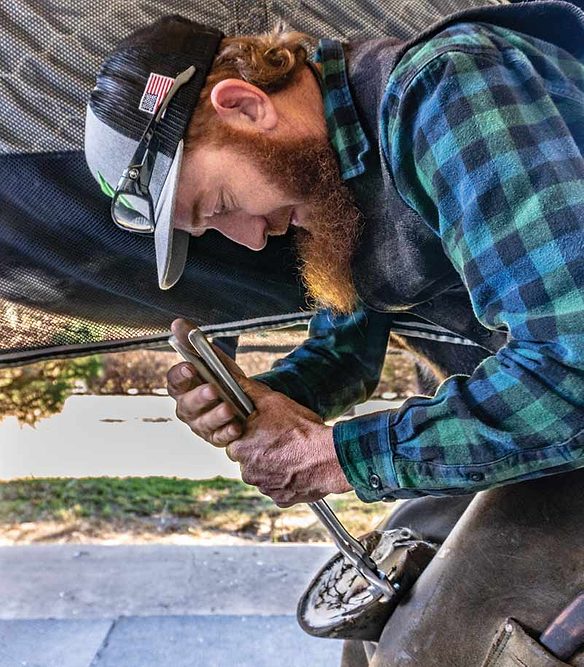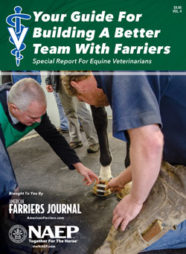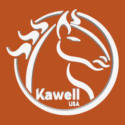Farrier Takeaways
- You need a solid reputation and to let your work speak for you to break into working with high-level performance horses.
- Look for creative solutions for clients that need help in managing horses between cycles.
- Invest in the associates who can further your practice.
Ty Garner traces his passion for farriery back to age 12 when his family moved across the street from a boarding barn in Utah. He would begin working there mucking stalls and doing other chores. At 14, he bought his first horse. Through this, he was drawn to horseshoeing.
Living in the Salt Lake Valley gave him access to farriers who helped turn his curiosities into a career. He credits Shayne Carter, Travis Swenson and Aaron Frye among others who challenged him to raise his game and fueled his passion for competition.
In a strange way, that was also a detriment. Garner says the valley has many top hands, but a limited number of high-level horses to match. Wanting to build his practice around top performance horses, Garner eventually relocated to Ocala, Fla., for its denser population of sport horses.
Although he is based in North Florida, Garner’s work isn’t fully localized — he travels to follow his clients on the circuit, taking him through the Northeast and Mid-Atlantic regions. On this “Shoeing for a Living Day,” he shows how his daily approach relies on the basics, but also thinking how best to keep horses in the show ring.
How to Keep Good Help
Garner backs his truck and trailer into the Greenbrier Farm, the Florida base for noted Australian eventing rider and trainer Clayton Fredericks. This was Garner’s first large account in the area, taking it over about 7 years ago.
Riding with Garner today is Dylan Deming, who has been with him for 6 years. After setting up their workstations, Deming pulls the shoes off of a warmblood that has been in the practice for 2 years.
As he trims the right forefoot, Garner notes the gelding’s feet can be more difficult to manage in summer, and will typically go with a leather pad and a pour on the front feet when they get chippy and break apart. Managing these feet is cyclical. The horse tends to be more stall-bound in summer to mitigate the effect of moisture. By early winter, the feet improve so that Garner then goes with an open heel shoe. The feet aren’t quite there on this December morning, so he’ll stick with this package.
LEARN MORE
Watch our extended interview with Ocala-based farrier Ty Garner as he updates us on how the sport horses are doing.
Deming will clean and trim the hinds while Garner shapes the front shoes. As Garner shapes the shoe he slightly widens the media branch.
“I want a wider shoe on his fronts because he stands on the inside so hard and widening it gives more coverage on the foot,” he says.
The Forgemaster sits on a cabinet next to Garner’s anvil in the trailer. Garner puts the pulled shoes on the counter for quick reference when shaping for the new shoes he’s working on the anvil. He says it is a good way to have a rough pattern and save steps to the horse. Garner notes that he rockers most of his fronts and hinds. It is a fairly mild rocker, but he finds it helps his horses break over easier and saves on the shoe wear.
Garner hot fits the right front while Deming drills and taps the left. Deming will take care of the other shoe when Garner safes and boxes the left. Garner says Deming’s skill and knowledge is an asset to his practice. It seems that good help is hard to find — or keep — for many farriers.
“When you find good help and they bring value to your business, you have to take care of them,” he says.
Garner says to get the most out of taking on an apprentice or associate, first determine whether they simply want to build a career. Invest the time in the person who picks up on things, asks questions and has drive.
“The first 2 weeks are the breaking-in point for someone new,” he says. “If you have to ask them to get out of the truck and set up stuff, you can realize you just have a helper. And that isn’t a negative. We can all use someone like that, but we really want someone who helps the business.”
Garner nails on the shoe and pad, and pours Farrier’s Choice. He says the urethane sets up well and he’s had success using it.

Florida farrier Ty Garner likes to put this slight rocker into his front and hind shoes. He finds it helps his horses move better and saves on shoe wear.
Preserving Sole Depth
After Garner nails on the warmblood’s hind shoes, Deming will finish the feet. He has already set up another warmblood that they’ll trade in the cross-ties. The next horse is one of Fredericks’s personal horses and an Olympic hopeful. Garner has been shoeing the horse for more than 3 years and says the horse is a pleasure to work with because Fredericks takes his time to train a horse to this level. As a result, Garner says the horses stand well for the farrier because of this patient approach.
Because Deming has already trimmed the hinds, Garner will start there. For the first horse of the day, they’ll usually start on the fronts, but let efficiency dictate how to work with horses the remainder of the day.
“Every horse after that, we simultaneously go back and forth,” he says. “If Dylan sees I’m still fitting fronts, he knows not to pull the fronts on the next horse. Whatever helps pace us so we don’t rush through.”
Garner says even in a strong team dynamic, it’s possible to get distracted and miss minor details so they are careful not to ignore any small steps.
“It happens — someone gets sidetracked and without noticing you nail on a shoe and then as you put the foot down, realize you didn’t put stud holes in,” he says. “The more of a hurry I get in, the slower I go. The key to the team is that everyone knows where the others are at in their work.”
After cleaning up the right hind, he hot fits the shoe. Garner notes the hoof wall separation and uses Cop-pure-cure to fill the voids. In this environment and the horse’s training regimen, Garner says it is critical to be aggressive to address the voids to maintain and improve hoof walls. This horse is at almost 5 weeks in its cycle, Garner is happy with the progress. He’ll reset the Werkman Warrior shoes.
The shoeing has to fit the horse and how the client is working it ...
With both hinds nailed on and clinch blocked, Garner starts trimming the front left. As he takes his nippers to the foot, Garner says while the horse generally has good feet, this foot is slightly higher than the other, but they aren’t significantly mismatched. In terms of managing a high-low case, Garner says he is more interested in a strong, healthy hoof capsule and the heels are back to the highest, widest point of the frog.
“I really try that with every foot I trim, unless there is a reason not to,” he says.
Moving to the right forefoot, Garner says he isn’t aggressive while paring the sole. For him, sole depth is critical to maintain with these horses given the nature of the work.
“But we feel we need to do something when we see the horse,” he says. “I’ve had horses on strict 4-week schedules and felt
the pressure to take just a sliver off. And then I found those feet weren’t growing, which puts me as the farrier in a self-preservation mode to get the feet to grow. Now, with most of these horses, we’ll run the course side of the rasp and burn them a little. Then on the next visit, we can remove more. It is easier to manage feet by staying out of the horse’s way.”
Garner will manage this foot with a minimal leather wedge pad to help the foot. Before he nails on the right front shoe and pad, he again addresses the voids, then paints the sole with Farrier Barrier for protection. He’ll finish nailing so Deming can finish.

The Bay Horse trailer is set up so Garner and Dylan Deming can both work inside. Garner sets another anvil — a Scott Mini Boy — by the horse to adjust his fit and save steps back to the trailer.
Your Work Speaks for You
As he takes his hoof knife to the right hind frog, Garner says this Thoroughbred gelding is fairly straightforward shoeing. The horse is on a 4-week schedule and there isn’t much new growth. Garner offers this as another example of a trimming scenario where the horse benefits from a “less is more” approach.
Fredericks comes by to quickly chat with Garner and Deming. Running a large equine operation, he wisely delegates footcare to professionals.
“Clayton says, ‘I ride them, you shoe them,’” adds Garner. “Keep their horses happy and sound, and you’ll come back.”
To work with higher-level horses, Garner says you must have the reputation, skill and knowledge required to help these horses stay in competition. He warns against being so intimidated by the perception of value that it distracts from how you work with the horse.
“We do the same thing with a $500 horse or $500,000 horse — both horses deserve the same level of care,” he says.
Garner finds two kinds of challenges in shoeing: managing feet and managing the business. When weighing the two, he finds footcare to be the more enjoyable challenge, and the business side to be fatiguing. Although there are different causes, he feels it usually comes down to having too many horses on the books. Of course, the common solution is to raise your prices to intentionally lose some clients while preserving income, but Garner says the reduction plan has to be a balance between raising prices and loyalty to long-time clients.
After trimming the fronts, Garner says he won’t be able to get another reset out of the shoes. In evaluating shoes for resets on four around, Garner tries to avoid making new shoes for both front and hinds on the same shoeing. He says it cuts down on the time with each horse. Plus, the horses stand better through a half reset.
Shaping the front right shoe, Garner says he looks at shoe wear at the end of the cycle, but doesn’t overanalyze it. He finds more information from watching the horse in the cross-ties while at the anvil. With this horse, its right foot is more forward.
“When I nail the shoes on him, I’m aware of that foot,” he says. “If I didn’t pay attention to that, and saw it later, I might think he was uncomfortable after nailing.”

Garner uses copper nails on all of his horses to avoid an inventory of rusted nails thanks to the Florida humidity.
Systematic Approach
After he nails the shoes on the Thoroughbred, Garner moves on to the next horse.
For evaluating a horse before working with it, Garner says he doesn’t invest time in watching the horse move. Instead, he finds more value in looking at various static criteria, such as weight-bearing and conformation. Garner reasons that if he stopped to watch each horse walk or trot, it would cumulatively cost him a horse each day. That’s not to say the goal is to speed through the day or cheat the horse.
“I take a systematic approach,” he says. “We have an agenda to go through daily and need to stick to it. We definitely aren’t rushing. We have a game plan for each horse. I can already tell how best to help it by observing the horse’s conformation or how it stands.”
Trimming the fronts, Garner notes how narrow-footed the horse is. He’ll reset the shoes, which are Kerckhaert DF hind patterns, with the clip placed between the first and second nail holes. To modify the shoe, he opens the toe up and straightens the branches.
Garner says he doesn’t make shoes at the horse, but skills he learned in his contest days have paid off for his practice. For a few years, he would make the hind shoes and modify keg shoes at the horse. After some time, he would reverse and make the fronts and modify the hind keg shoes. Garner says with the volume of horses to shoe each day and a baby at home, making shoes at the horse isn’t practical.
While checking his fit on the front left shoe, Garner takes a grease pencil and marks material that needs to be removed at the grinder. He picked up this tip from Kentucky farrier Bobby Menker, who uses the markings to guide his associates at the grinder. Garner likes it because the markings left on the shoe are waterproof and the precision will save guessing or unnecessary trips back to the horse.



Stud Options
Garner trades horses with Deming, moving on to a warmblood gelding that is a recent purchase from Europe. He sees this barn and other clients bring a fair number of horses over from Europe each year. Garner finds that horses coming from Europe tend to have good feet, but acknowledges it is a different shoeing style from what is typically seen in the United States.
“The challenge is getting those horses adapted to our style of shoeing,” Garner says.
One thing he finds is some of the newly arrived horses aren’t used to hot fitting, so Garner keeps his fans blowing at the horse while he hot fits.
Seeing this horse for the first time, he will use Werkman Strikers with a toe clip on the fronts. After burning in a clip, Garner likes using a small Nicholson half-round file to clean up the char area left by the clip.
“Once you burn them and they bubble up, I find if you don’t remove that crispy edge, the clip may not seat right back to where you had it before,” he says.
All of the shoes here are drilled and tapped. Garner’s setup is to drill on the press and tap using a clutch screw gun in the vise and an impact driver for cleaning out old holes.
Some of the shoes use the Klick and Ride stud system. The studs are screwless and rely on a ball-and-lock system into collars. Garner says these are a good solution for barns that have working students rather than grooms because they are easy to get in and out. Most of the work is on the farrier’s end to set the stud hole and collar.
“It is a better system than someone who might strip the stud out,” he says. “It would be good for horses that are difficult to get studs in when they hold their foot up. Instead, they can pop the thumb plug out and push in the stud.”
What’s Necessary to Keep the Horse Working
The final horse at the barn today is one that Fredericks qualified for the Olympic Games years prior. This is particularly challenging because the horse is still in competition, and is rough on its feet, especially in the stall.
“This is the type of horse that you need to find something that works,” he says. “Some people may look at what we did and question it. The shoeing has to fit the horse and how the client is working it. We all have these cases where we need to come up with a way to keep shoes on.”

Garner says checking landmarks is critical before and during your trim. More time spent focusing on the trim is his best way to avoid problems down the road.
To help this horse Garner went outside the box a few cycles ago by gluing Poly-Vectran with Equilox to all four feet, forming a lip to the white line. Then he will glue a rim pad in place to secure the overlap. The fiber and glue give more structural support so he could nail a shoe on. When applying the fiber, Garner says to roll it on lightly for better adhesion. You can add more layers after it cures. He credits retired Pennsylvania farrier Steve Teichman with this idea.
“This may not be the best for their feet, but the feet were in bad shape already, so we needed a solution,” he says. “We were wrapping his feet every 3 weeks and coming here each week, so we could look at his feet even if he wasn’t due.”
Garner says glue-ons are an option, but the client prefers to nail on a shoe if a horse loses one at a show. He will tape old sets and label them with the name of the horse so Fredericks has extra shoes on the team truck at a show.
Pulling off the Poly-Vectran, Garner says he is happy with the progress on all four feet. He feels that the walls have improved so he’ll skip the Poly-Vectran this cycle, leaving some of the texture coating to avoid weakening the hoof wall. He’ll continue to use the rim pads because he doesn’t want to be too aggressive in deconstructing the plan that has worked for the horse. There is thrush in the right front sulcus, so he squirts in some Durasole after trimming. He’ll give the feet a slight burn when hot fitting. He warns not to inhale the fumes from burnt glue that remains on the foot.
While Deming finished the horse, Garner reviewed his notes on the horses shod today. For invoicing a large account like Greenbrier that trains and boards, Garner keeps shorthand notes on the horses, documenting the dates and how he shod each horse. At the end of each month, he’ll tally the total horses and invoice the facility, which pays him. There are more tech-friendly ways to document and collect, but he doesn’t see the need to change when it fits the client’s business. For smaller accounts that he may see once a month, he still documents everything, but usually expects the client’s payment on the day of service.

Garner is adamant about farriers developing skills in the forge. Although he no longer builds shoes at the horse, he says the same abilities transfer to modifying manufactured shoes, like reshaping a hind pattern for a narrow forefoot for an appropriate fit.
Learn from Others
We arrive at the other stop today, Redfield Farm, a large full-service hunter/jumper boarding facility. Joining Garner and Deming are father and son farriers Shane and Ty Allen. Garner and the elder Allen work together often. Garner recommends taking the time to work alongside other farriers or watch them work. He says it will help you avoid burnout and you can always learn something you can adapt for your practice.
“I recently spent some time watching Dan Hausman work,” says Garner. “I watched how he was dressing his feet from the bottom. Before he nailed on the shoe, he chamfered the edges off with the rasp. This made sense to me, so I’ve changed and started doing this with my work and have seen it go through a full cycle.”
Redfield buys and sells a high volume of horses, so Garner may not have the opportunity to see them through enough cycles to make marked improvement. On a warmblood mare he’s seeing for the first time, Garner points to the high wall on the lateral left front foot. He says it is crucial to pay attention to the landmarks before trimming the foot.
Garner primarily uses St. Croix Eventers for aluminum shoes on a hunter’s fronts. He prefers these shoes because they hold up after being heated and throughout the shoeing cycle.
He’ll use a full leather pad with R.A.T.E. hoof packing, copper sulfate powder and oakum underneath the shoe. Garner likes the combination for its durability and protection of the foot.
Nailing on the hind with a thin lateral hoof wall, Garner says when he is fitting feet like this, he’s particularly attentive to where the nail holes align on the foot.
“I can fix everything else by modifying or grinding the shoe, but I have to make sure where my nails are supposed to be,” he says. “If I have the opportunity to shoe this horse again, I want to come back to a more solid foot.”

Garner uses this small Nicholson file on the hoof wall where he burned in clips for better seating.
Roadblock to Reevaluation
The final horse of the day is a reminder that despite best efforts to educate clients to choose the best footcare route for their horse, the farrier can be limited. Redfield is boarding a potential sale horse. The owner insists that the horse stays in its current package, which is similar to a flip-flop — a half shoe with a pad replacing the caudal aspect of the shoe. The owner says the horse is moving better than before in this package. The appearance of the foot tells a different story. Looking at the fronts, Garner notes the heels are underrun, damaged frogs and no hoof growth.
Garner has a good rapport with Darby Toben, Redfield’s manager, and talks to her about the feet. He recognizes they are in a tough situation with managing this horse and an unreasonable owner.
“I believe the back half of the foot has to be strong and healthy in order for the front half to be strong and healthy,” he says. “Therefore, when you have a pad such as this one that only covers a small portion of the frog, you’re not getting the positive frog contact that you would with leather or leather and pour. If you can’t follow good, solid basics of trimming and fitting well, it is time to reevaluate.”
He’ll reset the package and hopefully be allowed to implement changes down the road.
“Even though I explained to the team my perspective, sometimes you have to let things get worse until they are ready to let you try your way,” he says. “Maybe the pads worked temporarily because it was changed from something that wasn’t working. I think sometimes horses like change, but change can be good or bad.”
With fronts and hinds trimmed and the package reset, Garner and Deming pack up the trailer. Garner says that the assortment of horses is a typical “Shoeing for a Living” day for him — some sound feet and others where more is asked of the farrier. By taking his systematic approach and not rushing, Garner is well-suited to help them all.

Garner learned from Kentucky farrier Bobby Menker to use a grease pen for the grinder so that the markings aren’t washed away from moisture.
Related Content
Shoeing Sport Horses in Ocala with Ty Garner: In this video, Ocala-based farrier Ty Garner updates us on how the sport horses are doing.








